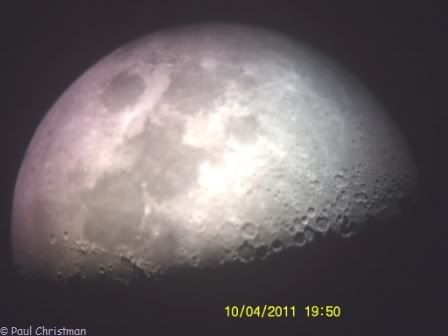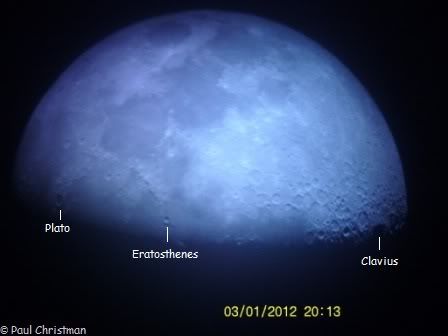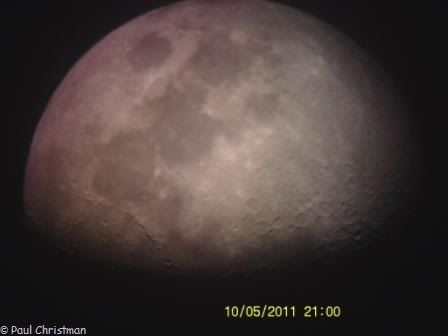I had never attempted a Messier Marathon before, let alone organize one. As the newly appointed Observing Director of Calumet Astronomical Society, I designated Friday, March 16 as a members observing night at Conway Observatory, with special emphasis on a Messier Marathon. I also invited a couple of friends from Chicago to join me for the Messier Marathon. Also, the Monday before the Marathon I was asked to have a training session for the observatory’s 16” telescope. I was okay with that, but also knew that it could easily interfere with the early part of the MM.
I arrived at Conway at 5PM to prep the observatory and look for any files that might be useful for the training session. I ate some burgers I picked up on the way, and made a pot of coffee to set out for the members. By 6:00 PM, members were arriving and setting up telescopes. I had already pulled out both of my scopes, and also an 8” loaner Dob from the basement storage. I was planning on doing the MM from the concrete circle, and thought I might want the extra 2” of aperture for some of the fainter targets. That would let the new trainees get familiar with the 16” telescope, and let me judge my progress with Jeremy, Bill, and John, who I knew were staying all night for the MM. At 6:30 I started the training class by going over the observatory rules and access policy. Just before sunset we were ready to go upstairs to open the roof and prep the 16” telescope. Just as Venus popped through the evening twilight, the trainees were ready to slew the telescope to their first target of the night.
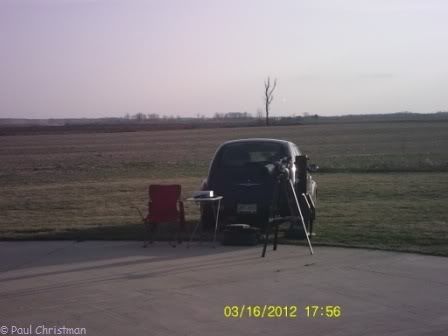
Gear out, and ready for the night.

Craig solar observing.
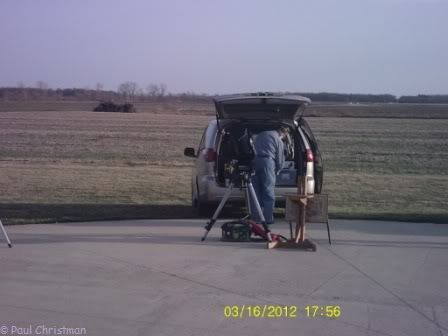
Mike setting up.
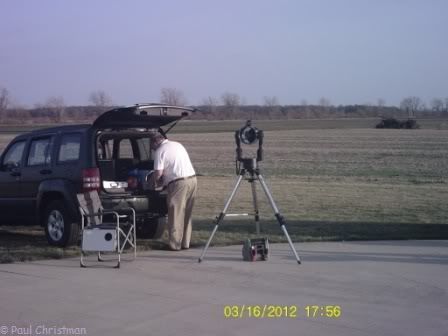
Jeff setting up.


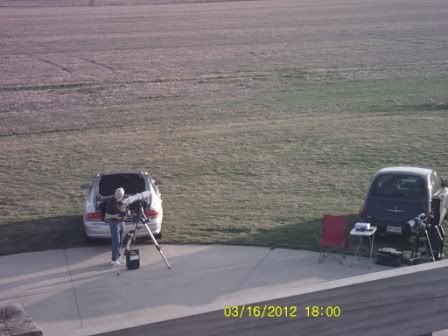

Larry sets up his truss tube Dob.
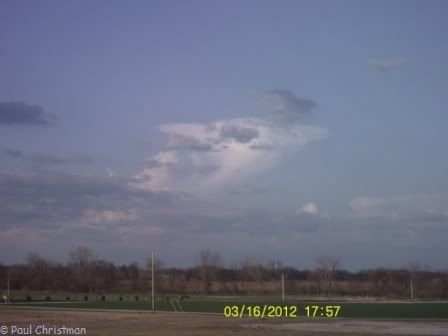
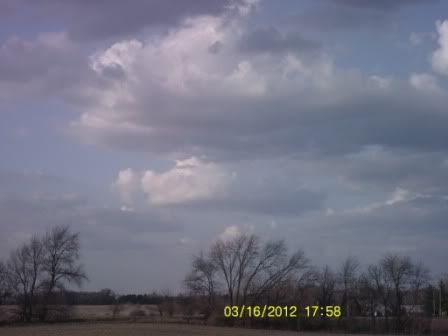

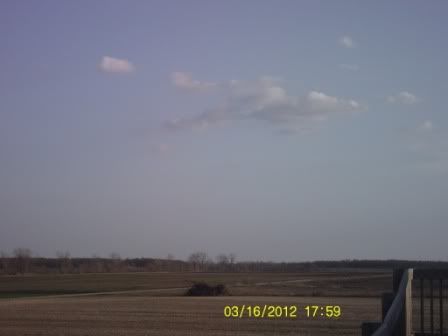
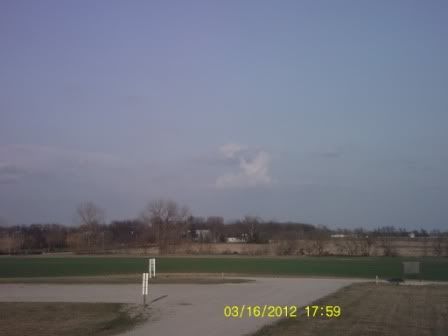
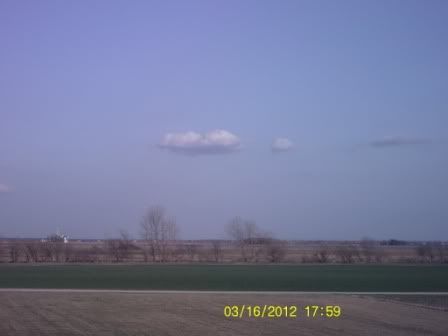


Quick solar observing for me.
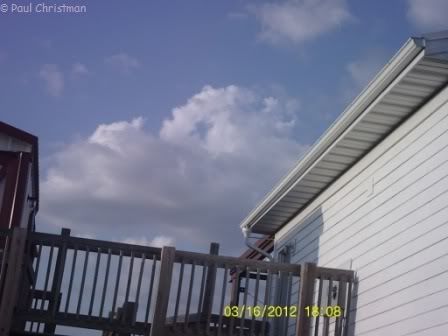
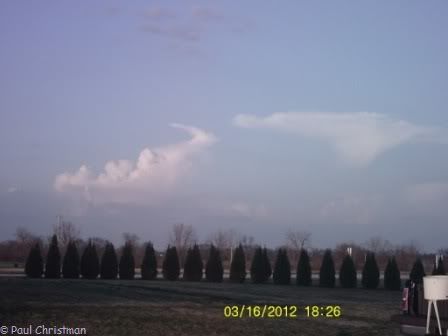
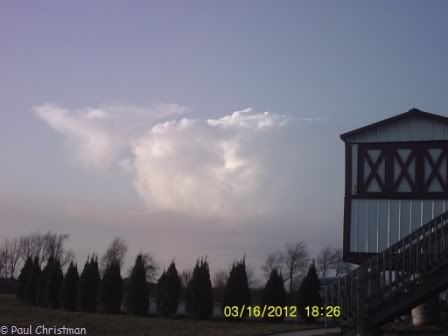
Venus, Jupiter, and Mars shined down on us early, and most of my class had never seen them through the 16” telescope. I was done with the class when Bill and John arrived, so I gave John a quick tour of the place, and let him have a look at Jupiter, Mars, and M42 with the 16”. Wow, wow, and WOW. Yep.
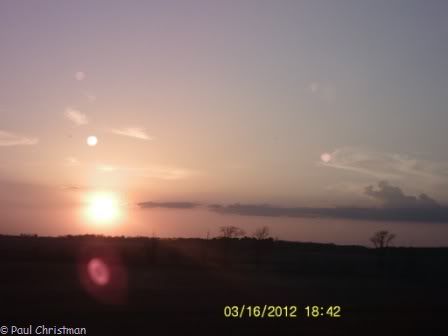
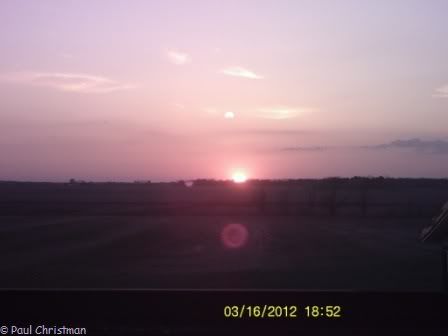
Sunset.

Roger works the 16" LX200.
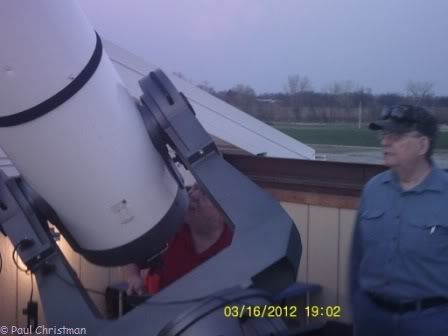
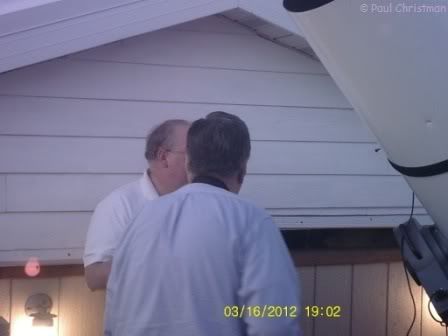
Jim and Jeff wait their turn.
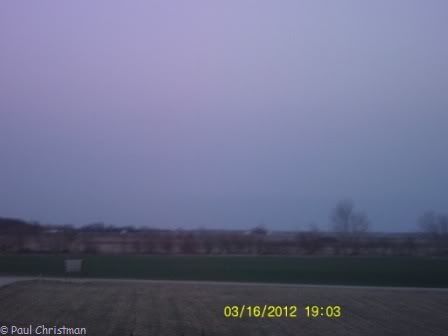
Jeremy was already searching for the early galaxies, M74 and M77, which are difficult at best. I was almost set to go myself when somebody pulled me away again. A guy had stopped by curious about what we do and how to join. I showed him around and let him and his wife look at the bright planets that were up before getting back to the Marathon.
FINALLY. Observing time. I really wanted to start the night off right by catching the faint galaxies of M74, M77, and M33. Jeremy had all but given up on them, but managed to track down M31 and companions. I was struggling with it, and gladly had a look through Jeremy’s Dob for M31 & 32? At 8:33 PM. At 8:46 I thought I found M52, an open cluster in CAS. I wasn’t positive about it, so again, when Jeremy said he’d found it, I had a look at 8:54. I was pretty sure at that point that I hadn’t found 52 at all. Pushing 9:00 PM, two hours after sunset and I hadn’t logged a Messier of my own yet. That was about to change.
At 9:01 I logged open cluster M103 in CAS. This reminded me of mini versions of the summer asterisms Sagitta and the Coathanger. After struggling again on something (not sure what), I pulled out my binoculars for Suburu, M45 at 9:11 PM. Yeah, yeah, it’s easy, but I needed the confidence boost. Number 2.
Somewhere around this time, from the other side of the observing circle, Larry asked me to come over and confirm that he had found our long-running icy friend Garradd. It was good to see the comet again, especially without having to waste time tracking it down. Ha! I saw a comet. Take that, Messier!
Perseus was heading toward the northwest light dome, so it’s two Messier’s had to be checked off while I had lower magnitude guide stars to find them. I checked off planetary nebula M76 at 9:26 PM. It needs power, and an OIII filter helps, but it was visible without it. I don’t think I even starhopped to M34, but picked up the faint glow through my finder scope. Finally an easy one!
Next I headed south of Orion to Lepus for my first globular cluster of the night, M79, at 9:42 PM. I stopped at the very familiar M42 & 43 just long enough to write them down, then on to M78, another diffuse nebula in Orion. I actually found M78 easily enough, but wasn’t convinced of it. I was expecting something more like M42 or M8. What I saw was two stars and a faint glow. I reworked my starhop several times, and kept coming back to it. When the others were seeing the exact same thing as I was, I logged it at 10:02 PM.
For the very beginning of Frenchy’s list, I went up to the 16” scope. The 8” Dob I was working with would have done just fine, but this one is great with large aperture. Logged the Crab at 10:08 PM. I’d been working through the list for over an hour and a half, and had only logged 12 objects; two were naked eye objects, and three I hadn’t even found myself. Time to go on a roll, and Auriga was the perfect place to start that roll.
M35, open cluster, GEM- 10:21 PM.
M37, open cluster, AUR- 10:24 PM.
M36, open cluster, AUR- 10:26 PM.
M38, open cluster, AUR- 10:27 PM.
Four clusters, six minutes. Much better. Added open cluster M41 below Sirius to the list at 10:28. Five in seven minutes. Heating up, but yet another open cluster, M93 in PUP, slowed me down again, not observed until 10:45 PM. M93 shares PUP with two more Messier open clusters, M47 & M46. M47 was logged at 10:50 PM. Although they are right next to each, I didn’t officially log M46 until 11:00 PM. I had no trouble finding it; I just felt that as long as I was there, it was worth the time to find the cluster’s hidden planetary nebula, NGC 2438. It was visible, but not discernible. Popping in an OIII filter dimmed the background cluster enough to reveal the faint glow of the dying star. Worth the time and effort, I think.
From M46, I made my way up to open cluster M48 in HYA at 11:10PM. “Not too bad” is my only comment on the cluster. After that, M50 in MON should have been next. Looking at a chart now, it should have been a fairly easy find, but I gave up on it. Sitting between Sirius and Procyon, there just aren’t many bright stars between the Dogs to get a close starting point.
I didn’t like giving up on M50, but I didn’t want to fall further off the pace. I was running behind the others, and felt pressured to catch up, even at the expense of a Messier object I’d never seen. I was quite happy to see M44, the Beehive Cluster next on the list. It was “too friggin’ big” for my 25mm eyepiece, so I took a nice look at the cluster through the finder scope, somehow avoiding back injury. After the Beehive, a short trip south through Cancer brought me to M67, a “small, tight” open cluster I’d never seen. I won’t be making the mistake of passing it over nearly as often now.
After logging M67 at 11:28 PM, the Leo galaxies were next in the order of my observing plan, but I deviated from that plan. Ursa Major was swinging around to the darkest part of the sky it would be in. For some reason the Big Bear gives me fits, even M101, which is an easy starhop above the handle. I was going to need as many guide stars as I could get, so wanted to get through UMA before it headed into the background glow to the northwest. I started with the galactic pairing of M81 & M82 at 11:38 PM. Along the bottom of the Dipper, spiral galaxy M108 looks easy enough to target, but this dim, edge-on spiral is hard to spot. I found it at 11:46 PM. From there, planetary nebula M97 is practically right next door. This is a large planetary, but dim. Once again, I gave it a look with the OIII filter at 11:53 PM. The next target, spiral galaxy M109 is not much trouble to target, but “very dim.” Duly recorded at 11:57 PM, I moved on. As noted above, spiral galaxy M101 has some nice stars to point the way, yet I had to make this starhop several times before finding it at 12:06 AM.
Here is where I started having doubts about Messieur Messier. I had conflicting data about spiral galaxy M102. One of my sources listed it as NGC 5866, but another said it was a duplication of M101. It wasn’t listed in the index of my star atlas, so I skipped it for the time being. Later, I would regret that decision, but I had doubts that it even belonged on the list.
We’re all familiar with M51, just off the Dipper in Canes Venatici. There are three other Messier galaxies nearby in the Hunting Dogs. I started with M51 and companion at 12:08 AM, then started my starhop for M94 at Beta CVN. M94 forms the point of an isosceles triangle with Beta and Alpha CVN as the baseline. I lined up the finder scope at what I thought was the appropriate spot, and there it was. 12:12 AM. M63 is about 2° northwest of 4.73 magnitude 20 CVN. I found the galaxy at 12:15 AM. The last Messier galaxy of the Dogs is M106. It lies about halfway between Gamma UMa and Beta CVN. M106 has a visual magnitude of 8.4, but a surface brightness of only 13.6. I didn’t find it, and was losing time in the search.
The next targets were worth seeing with the 16”, so I went upstairs for a look not only at the Leo galaxies, but a quick diversion to see the Red Planet. First, though, was a quick stop to the Sombrero Galaxy, M104. The Sombrero is technically a Virgo galaxy, but it’s just north of the border with Corvus, and I always start my starhop at Delta Corvus. Throwing high power at M104 reveals it’s famous dust lane. I shared the view, and logged the Sombrero at 12:45 AM.
Moving to Leo, the next target was one of the easiest to find, at least this night. Spiral galaxy M96 shared the field of view with Mars. Cheating? Maybe, but I still needed to make up time. After observing Mars, I nudged to telescope southwest so that the galaxy and Mars shared the 40mm eyepiece of the 16”. It might be the first time I’ve ever seen a galaxy and planet together. M95 is just west of M96, so again I nudged the telescope over, and logged the pair at 12:53 AM. Next was M105, just northeast of M96. The cool thing about M105 is that it shares the field of view with galaxies NGC3384 and NGC3389. I saw them all at 12:56 AM. Below 70 Leonis lies the pair of galaxies M66 and M65. Again, I caught them sharing the field of view. It’s nice to check off two at a time, which I did at 1:00 AM.
I went back down the observing circle to work the objects in Coma Berenices. First, though, I had M40 on my list. Again, I was cussing Messieur Charles. This is just a double star, and not a good one at that. Knowing that Messier first published his catalog at 45 objects, and with M42 through 45 being naked eye visible, I really feel that he was just padding the list for publication. I can’t prove it, but it makes sense. Of course, M40 wasn’t listed in my star atlas, but after some investigating, I’m pretty sure I tracked down the right double, and noted it at 1:12 AM.
Around this time Jeremy was hunting M102. As I stated above, I had conflicting data on M102. One source listed it as a duplication of M101, while another said it was NGC5866. After hearing what Jeremy read from his source, I decided that I would try to hunt down NGC5866 in Draco. Still cussing and complaining about Messier’s observing skills, Draco had moved into the glow from the cities and towns to the northwest. I gave up on it, but will put a higher priority on it for my next Messier Marathon. But once again, I lost a lot of time on something I hadn’t even found.
Before getting to the galaxies of Bernice’s Hair, at 1:29 AM I found the globular cluster M3 in Canes Venetici, near where it converges with Coma and Bootes. I love globular clusters, and M3 was only the second one on the list. Globular cluster M53 was in the area though, and observed next at 1:38 AM. M53 lies about 1 degree east of Alpha COM. Very faint, and now in the running with M107 as the worst Messier globular. The famous Virgo Cluster of Galaxies is concentrated in Virgo, but some of the physical members of the cluster spill over into Coma. M64 is the northern-most Messier member of the cluster, off by itself. I found it less than a degree from 4.9 magnitude 35 Comae. I had my first galaxy of the cluster at 1:47 AM, but I wasn’t quite ready to dive into the thick of them yet.
The Messier objects of Hydra, M68 and M83 were near the central meridian, and about as high as they were going to be. Neither was very high above the horizon, so I had to take advantage while they were peaking. Globular cluster M68 lies about three degrees south of Beta CRV. When I found it 1:56 AM, I found no resolvable stars, but the transparency was terrible, especially that low to the south. At 2:04 AM I found the spiral galaxy M83. In my notes I wrote, “faint,” then started to write, “Wha…” but crossed it out. I think I was ready to badmouth Chuckie again…
With Hydra knocked out, I was ready to tackle the Virgo Cluster. I really expected to run right through these galaxies. My experience of early morning February 19 touring some of the Virgo galaxies was relatively fresh in my mind. Also, I thought I was going to use the 16” LX200 to go through the cluster. Fate had other ideas, and left me spooked as well.
Just as I was getting ready to go upstairs to the observatory, I turned around and swore I saw white light flash across the parking lot, like a car was pulling in. We’d had several cars turn in already, just to leave when the saw us observing. I was ready to let somebody have it for showing up uninvited after 2AM, but there was no car there to be seen. Freaky, but okay. We had lightning flashes later in the morning, so maybe that’s all I saw. I went upstairs to work the 16”, but the freaky would continue.
On an equatorial mount with a wide field eyepiece, the Virgo cluster is easy to go through. Many of the galaxies can be found by slowly slewing in only one direction from the previous galaxy. This makes it very easy to galaxy hop through the cluster. When I used the LX200 for Mars and the Leo galaxies, the handset was behaving oddly. It was annoying, but usable. It acted like it was rebooting several times, and didn’t want to slew at the slowest control speed. With new members using the telescope earlier in the night, I thought maybe settings had been changed (inadvertently or not). Or perhaps dew, which was became a problem after midnight, was shorting the wiring. At any rate, I didn’t have the time to investigate. I was going to turn the power off and head back down to the 8” Dob, but first the 16” decided to slew of it’s own accord. I ran down to the control room, and flipped the power switch. I was freaked out. Spooky incident number two in just a matter of minutes. I was ready to get back outside, but as I opened the door, it looked like it was locked from the inside. WTF? I had just come through the door without a key! I hurried back down to the concrete circle with the feeling that Messier was messing with me for cussing him out! I know that sounds crazy, but I’d just had a little too much crazy. I needed coffee.
Settled down and caffeinated (not at all an oxymoron to me), was finally ready for the Virgo Cluster. I did NOT want to do this with a Dob. I’ll try to spare every little detail, but I knew that I was going to be doing a lot of backtracking through galaxies, starting all over again, or both. First up was M98. I got REAL familiar with M98. I started at Denebola (Beta LEO), then went nearly due east to 6 COM. M98 is less than one degree from 5.1 magnitude 6 COM, the brightest star in the area. Also, being the westernmost of the 14 galaxies at the heart of the Virgo cluster, it made sense to use M98 as my starting point. I first saw it at 2:23 AM. Practically right next to it is M99. I didn’t log M99 until 2:34 AM, eleven minutes later. Nope, I did NOT want to do this with a Dob.
Long story short, I was very methodical as I went through the Virgo cluster. I made sure that I was not mistaking one galaxy for another by confirming them through the galaxies surrounding each one. All told, it took me one hour, eighteen minutes to observe the fifteen Virgo Cluster galaxies starting with M98 and finishing with M61 at 3:41 AM, an average of one galaxy every five minutes. Not shabby, but I felt I could have done better. Again though, conditions were poor at the beginning of the night, and continued deteriorating through the night.
Virgo Cluster
M98- 2:23 AM.
M99- 2:34 AM.
M100- 2:50 AM.
M84 & M86- 2:58 AM. Shared field of view.
M49- 3:05 AM.
M87- 3:07 AM.
M58- 3:09 AM.
M89- 3:12 AM.
M90- 3:16 AM.
M59 & M60- 3:18 AM. Shared field of view.
M88- 3:35 AM.
M91- 3:35 AM.
M61- 3:41 AM.
When I finished the Virgo Cluster, Jeremy was having a look at Saturn. This was a nice planetary break after the intense concentration of finding the faint Virgo galaxies. I have to say, this was my best view of Saturn ever. Really. If I remember right, Jeremy was pushing unreal magnification, using his 3x Barlow and 8mm EP. The air was still enough to support it, though, and it was like looking at the system from Cassini. If Saturn looked this good every time, there would be no doubt what planet would be my favorite. Sorry Patrick.
Now we’re pushing 4 AM, everything is soaked with dew, and we started seeing lightning flashes with no clouds in sight. By 4:30, though, I could see clouds in the lightning to the northwest against the dome of Purdue Calumet’s NIRO observatory. I closed the roof then, just in case a storm popped up.
After the diversion of Saturn, I was ready for some easy observing. I chose M29, an open cluster in Cygnus to resume the Marathon. Against the star rich field of the Cygnus Milky Way, this cluster isn’t impressive. Recorded it at 3:56 AM, and went to Lyra. Normally M57, the Ring Nebula, is one of the best objects to observe. For the Marathon, however, I was content to log it at 3:57 AM, and move on. Ditto for globular cluster M13 in Hercules, at 4:03 AM. The Little Brother glob in Hercules gave me some trouble, but I finally found it at 4:12 AM. Those two put me on a glob kick, though.
M107 in Ophiuchus is an unimpressive, tiny, faint globular. It’s an interesting starhop (if you go the long way around). This might be the worst Messier glob, but I found it at 4:17 AM. I was going to try for the rest of the globs in Ophiuchus, but transparency was so terrible that I could hardly make out the naked eye stars of the constellation, let alone find dimmer stars for a proper starhop. I gave up, and went over to my constellation, the Scorpion. M4, just off Antares (Alpha SCO), was easy enough at 4:25 AM. M80 was harder, found at 4:32 AM.
After closing the roof I decided to take all of my observing gear except telescope into the observatory basement to dry out under the heater. The sky was just too bad for serious observing, and I knew my Marathon was over. I managed to add six more objects to my list just to make my final tally slightly more respectable, but if I couldn’t find something in a matter of minutes, I skipped it. This was the summer sky, where I’m very much at home, and have seen most of it’s Messier objects repeatedly, as well as a good chunk of it’s NGC objects. For deep sky observing, nothing makes me happier than glob-hopping through the summer constellations, so I was disappointed that the sky wasn’t going to let me see my favorite treasures. I have all summer to get reacquainted, though. Slowly, and between cursory searches, I started closing down the observatory.
Ptolemy’s Cluster, M7, was a somewhat easy find at 4:53 AM. M7 lies about 5° east of Lambda Scorpius, and is naked eye visible under dark skies. With his shorty refractor, Bill showed me a wide field view that included M20, M21, and M8. Right after that I went after the big, bright M22. M22 is special to me. When I first bought my Dob in 2008, Jupiter was hanging out in Sagittarius. I had bought my Dob for lunar and planetary observing, thinking that the 6” aperture was too small for deep sky objects. One night at home I realized that I could see a hint of the summer Milky Way overhead. Immediately I started scanning the sky through my finder scope, and quickly saw M22 glowing. It was the first DSO I ever saw on my own, and to this day is one of my favorites. For the Marathon, I logged it at 5:29 AM. Lastly, I found globular cluster M28, about 1° northwest of Lambda SGR. That was my 74th and final Messier object of the night.
By 6:00 AM, the sky was getting brighter in the east, and we started losing stars. We could also see just how thick the fog surrounding us was. We had warm temperatures all night, at worst only dipping into the upper 50’s. Some of the guys who were out for the members observing session chided us that it wasn’t a Messier Marathon unless it was 30° or colder. I almost would have welcomed a cold night if it would have given us a crisp, transparent sky. We fought for every object we saw, especially in the later hours. I was impressed with the observing skills of John, Bill, and especially Jeremy. I remember Jeremy’s first night at Conway last summer, using his binoculars and borrowing my Dob to observe. He’s come a long way since then, and was without a doubt the most intense observer throughout the MM. He was finding dim fuzzies right up until the morning sky became too bright. Thanks to all of them for staying out all night, and pushing me to try to get through as much of the catalog as I could. Maybe next year we’ll have more favorable sky conditions, and catch all 110. There are now only a small handful of Messier objects I’ve never seen, and those will get high priority to observe in the next year.


Morning fog all around us. We'd been observing through it for a couple hours, at least.
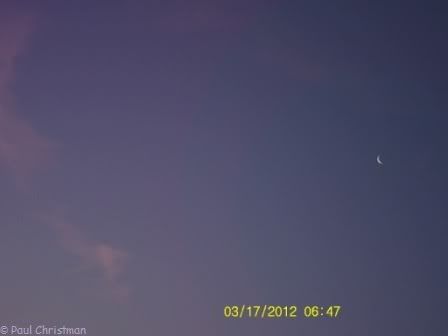
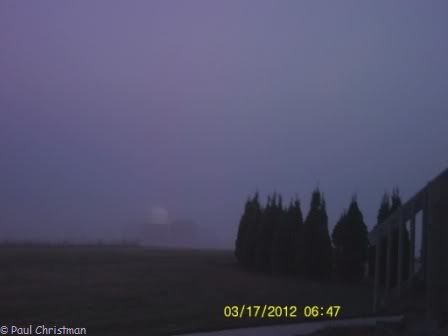
Purdue Calumet's NIRO observatory is barely visible, only about 100 yards away.

Apparently this mouse picked a bad time sometime during the night to try to sneak out of the building. :-/

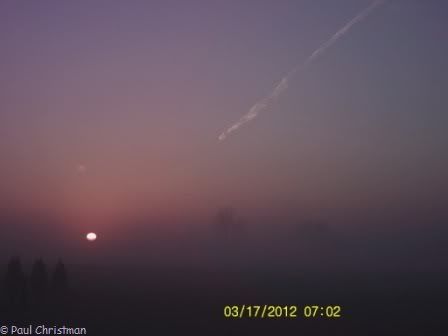
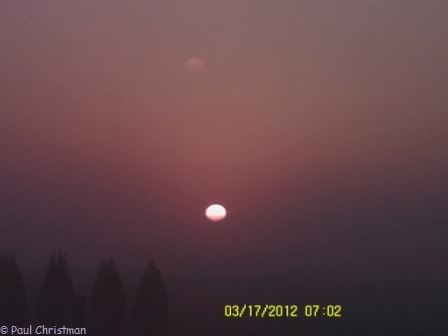
Foggy sunrise.

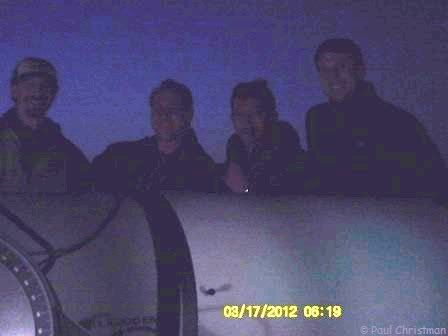
Our all night Marathon crew. L-R: Me, John, Bill, Jeremy.

Time to go.
More here.

